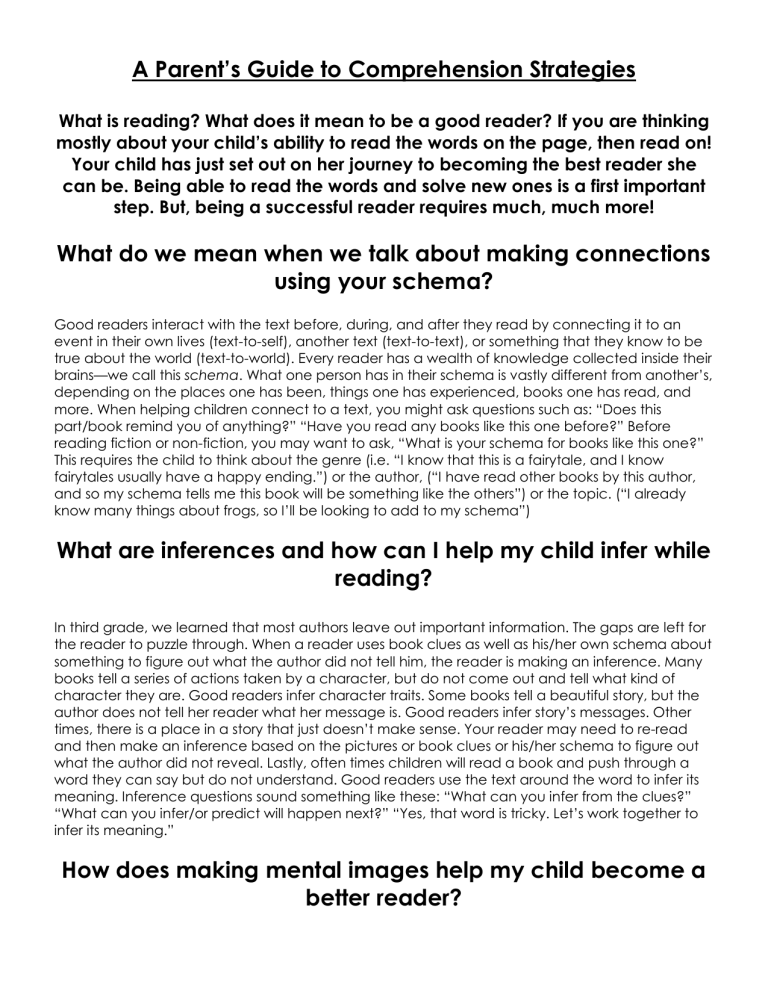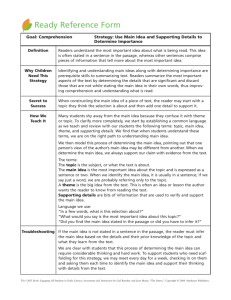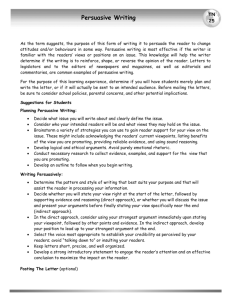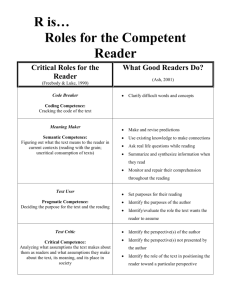A Parent's Guide to Comprehension Strategies

A Parent’s Guide to Comprehension Strategies
What is reading? What does it mean to be a good reader? If you are thinking mostly about your child’s ability to read the words on the page, then read on!
Your child has just set out on her journey to becoming the best reader she can be. Being able to read the words and solve new ones is a first important step. But, being a successful reader requires much, much more!
What do we mean when we talk about making connections using your schema?
Good readers interact with the text before, during, and after they read by connecting it to an event in their own lives (text-to-self), another text (text-to-text), or something that they know to be true about the world (text-to-world). Every reader has a wealth of knowledge collected inside their brains—we call this schema. What one person has in their schema is vastly different from another’s, depending on the places one has been, things one has experienced, books one has read, and more. When helping children connect to a text, you might ask questions such as: “Does this part/book remind you of anything?” “Have you read any books like this one before?” Before reading fiction or non-fiction, you may want to ask, “What is your schema for books like this one?”
This requires the child to think about the genre (i.e. “I know that this is a fairytale, and I know fairytales usually have a happy ending.”) or the author, (“I have read other books by this author, and so my schema tells me this book will be something like the others”) or the topic. (“I already know many things about frogs, so I’ll be looking to add to my schema”)
What are inferences and how can I help my child infer while reading?
In third grade, we learned that most authors leave out important information. The gaps are left for the reader to puzzle through. When a reader uses book clues as well as his/her own schema about something to figure out what the author did not tell him, the reader is making an inference. Many books tell a series of actions taken by a character, but do not come out and tell what kind of character they are. Good readers infer character traits. Some books tell a beautiful story, but the author does not tell her reader what her message is. Good readers infer story’s messages. Other times, there is a place in a story that just doesn’t make sense. Your reader may need to re-read and then make an inference based on the pictures or book clues or his/her schema to figure out what the author did not reveal. Lastly, often times children will read a book and push through a word they can say but do not understand. Good readers use the text around the word to infer its meaning. Inference questions sound something like these: “What can you infer from the clues?”
“What can you infer/or predict will happen next?” “Yes, that word is tricky. Let’s work together to infer its meaning.”
How does making mental images help my child become a better reader?
As adult readers know, making pictures in your mind is something that most readers do when reading. Young readers often do not feel the need to form a picture while they read, since pictures are usually provided! However, since making mental images helps readers step into the story and more fully comprehend the plot, making mental images is an important skill to practice.
Help your child make mental images this summer by choosing a great children’s novel to read aloud. Ask you children’s librarian to help you choose a good one, or pick one YOU enjoyed as a child. Remember, even though you may be used to visualizing while you read, making mental images is not necessarily a reflex. While you read, check to see if your child can “paint you a picture.” Have them tell you what they see, and in turn, you tell them how you images are different. After all, no one has the same mental images, because everyone has different schema!
When is it appropriate to encourage my child to ask questions, and what do I do if the author does not answer them?
Since children are naturally brimming full with questions, it is easy to funnel their question-asking talents to help them more fully interact with books. Good readers ask questions that they have before reading, during reading, and after reading. If you and your child are reading a book that is of high interest to your child (especially non-fiction), you may want to consider keeping track of your before, during, and after questions. Most questions are not answered right away, some are there if you look hard enough, and others are not there at all. Help your child answer questions that he/she may have by writing them down and then reading to find them. Remember, especially in fiction, readers infer (meaning they use the book clues as well as their own schema) to find answers. If your child’s question is not answered in that text, you may want to encourage him or her to pursue the answer in other places. Keep those questions coming, and your child will have a perpetual thirst for knowledge!
What is synthesizing?
All reader synthesize. When adult readers stop at a chapter break or put down their book and say something like, “Oh!” or “Ah-hah” or “Huh?”, he is synthesizing what he’s reading. If a reader is truly interacting with a text, then his understanding of that text changes frequently throughout the story.
You can model synthesizing to your first grade reader by saying things like, “Oh! At first I thought
____, but now I’m thinking____” Or, “So that’s why it said, ____ at the beginning. Now I get it!” Also, when you stop at the end of a book to process what you have learned or to think about what the author is trying to tell you, you might say something like, “I thought this book was going to be about ________, but it turns out the author had a different purpose for writing!” Or, “I think the author’s purpose/message was __________” Synthesizing is really all about helping and modeling for children so that they can take responsibility for what they understand, what they don’t understand, and what pieces of their schema have changed as they read.








